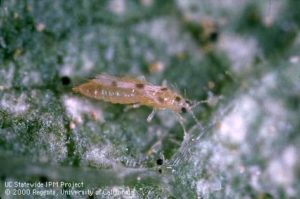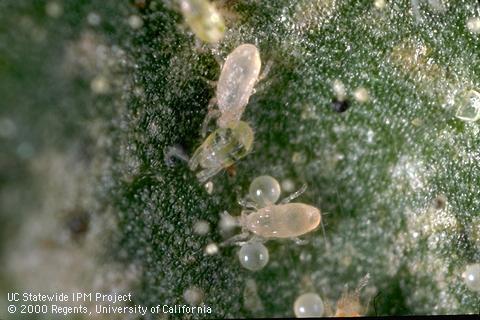Spider mites are considered indirect pests in almonds and walnuts, in the sense that they do not feed directly on the harvested product. Rather, they cause injury to plants by sucking cell contents from foliage. Signs of feeding injury include leaf stippling, yellowing, and dropped leaves. High populations of mites can also be recognized by webbing on leaves and tree terminals. Significant spider mite injury can become economic crop damage in almonds in subsequent seasons in the form of reduced vegetative tree growth and crop reduction. In walnuts, early season defoliation can reduce nut yield and quality that year. In both commodities, excessive leaf drop can interfere with harvest operations.
Effective management of spider mites is a good example of how the integration of multiple tactics is necessary to achieve optimal population suppression and damage reduction. For spider mites, we must focus on three key management tactics: cultural practices, biological control, and miticide applications when treatment thresholds are reached.
Cultural practices. Properly-irrigated, vigorous trees are less susceptible to spider mite damage. Ensure that trees are not stressed due to inadequate irrigation, fertilization, or other factors. Reduce dusty conditions by oiling or watering roadways and, where possible, maintaining ground cover.

Biological control: Spider mites have a suite of natural enemies that can occur to varying degrees in the orchard environment. The most impactful of these biological control agents in California almond and walnut orchards are typically predator mites (Photo 1) and sixspotted thrips (Photo 2). When we think of biological control in practice in most orchard environments, we are largely discussing conservation biological control – in other words, with respect to the beneficial predators, “don’t starve them, don’t kill them.” This means that we have to be willing to tolerate some level of food source in the orchard to maintain predator populations. Food sources may come in the form of other mite species early in the season (e.g., European red mite, brown almond mite), as well as subeconomic populations of spider mites themselves throughout the season. We must also be mindful of the impacts of all pesticide applications on natural enemies (more on that below).
Pesticide applications: When deciding whether or not to treat spider mite populations in almond and walnut orchards, multiple factors should be considered. Applications of pyrethroids and organophosphates (used to manage insect pests) are particularly disruptive to natural enemy populations. If scouting indicates presence of beneficial insects such as predatory mites and/or sixspotted thrips, bear in mind the impacts of your chosen material(s) when making applications targeting other pests as well as spider mites throughout the season. The University of California Integrated Pest Management Guidelines regularly update the “Relative Toxicities of Pesticides to Natural Enemies and Honey Bees” online. These can be found for almonds and walnuts at: http://ipm.ucanr.edu/PMG/r3900311.html and http://ipm.ucanr.edu/PMG/r881900111.html.
Based on years of research, the University of California has developed monitoring and treatment guidelines for managing spider mites in almonds and walnuts. These thresholds take into account the population densities of both spider mites and their predators (as well as the use of disruptive insecticides). Ideally, the goal is to maintain an adequate predator-to-spider mite ratio in the orchard to allow the natural enemies to assist in keeping spider mite populations below economically damaging levels. Decision trees based on these guidelines are shown in Figure 1 (almonds) and Figure 2 (walnuts) and can be found at www.sacvalleyorchards.com.
In almonds and walnuts, monitoring involves presence/absence detection of spider mites and their predators. This process saves time because it is not necessary to count individual spider mites and predators. Instead, the goal is to tally the numbers (or percent) of total leaves sampled that contain one or more spider mites and/or their predators. Monitoring in most years should begin by May (almonds) and June (walnuts) and continue at least weekly through August. Remember that warm conditions drive spider mite development and reproduction rates. Monitoring may need to begin earlier some years and the frequency of monitoring should increase as temperatures increase.
Walnut Mite Decision Tree FIGURE 2 WCNGG
In almonds, early season monitoring should focus on known hot spots or areas along dusty roads or with water-stressed trees. Once a treatment threshold is reached in these areas that are prone to developing spider mite outbreaks first, sample the remainder of the orchard to determine if spot treatments may be sufficient. Later in the season (typically after mid- to late June), monitor the entire orchard, dividing it into sampling areas that could be treated separately if thresholds are only reached in certain areas. Monitoring for spider mites in almonds involves a sequential sample, in which the total number of trees and leaves examined depends on numbers of leaves detected with spider mites and/or predators. The process begins by selecting 75 leaves (5 each from 15 trees) in your defined sampling area, and looking for presence/absence of the pest and natural enemies. Randomly select leaves from all sides of the tree, and from inside and outside of the tree canopy. Tally the total number of leaves with spider mites and total number with predators. A monitoring form can be found at http://ipm.ucanr.edu/PMG/C003/almonds-mites.pdf. Results can then be compared to the decision tree (Figure 1) to help determine whether treatment is warranted at that time. If a decision is not clear after the initial 75-leaf sample, the process continues (15 leaves, 1 tree at a time up to a maximum 300 leaves) until a decision can be made.
Almond mite decision tree FIGURE 1 WCNGG
In walnuts, randomly select 10 trees per sampling block. Examine 5 leaflets from low branches and 5 leaflets from high branches in each tree, again noting presence or absence of spider mites and their predators on each leaf. A monitoring form can be found at http://ipm.ucanr.edu/PMG/C881/walnut-mitemon.pdf. Compare results to the decision support tree (Figure 2) to help determine whether treatment is warranted at that time.
Effective and sustainable spider mite management in almond and walnut orchards will only be possible through adoption of sound IPM practices. It may be tempting to treat spider mites prophylactically (i.e., before economic thresholds are reached), but take caution when choosing this method. Overuse of certain materials and the perceived benefits of a “free ride” (adding a miticide when treating for other pests or pathogens earlier in the season) may ultimately result in increased difficulty in managing these pests due to resistance development and destruction of natural enemy populations. While every orchard environment has its own unique set of circumstances, diligent monitoring and careful decision-making are the keys to maintaining economic and ecological viability when faced with our many pest management challenges.











